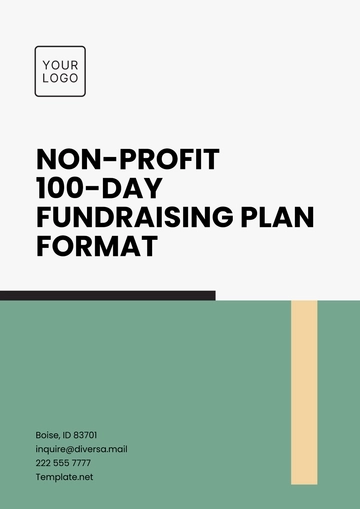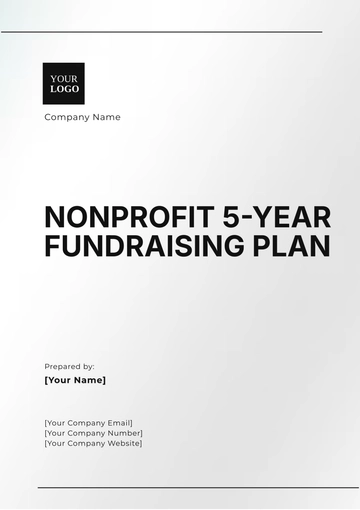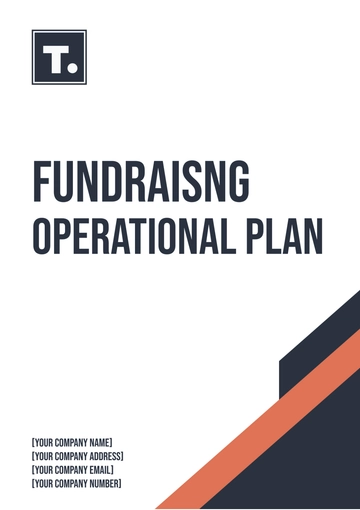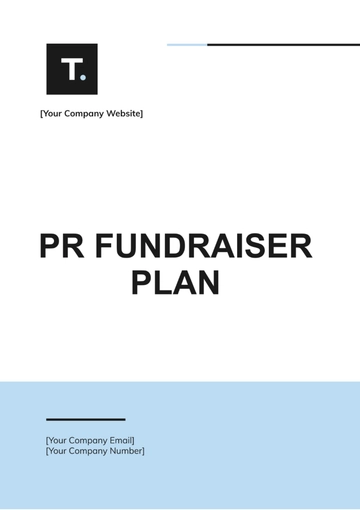Free Fundraising Operational Plan
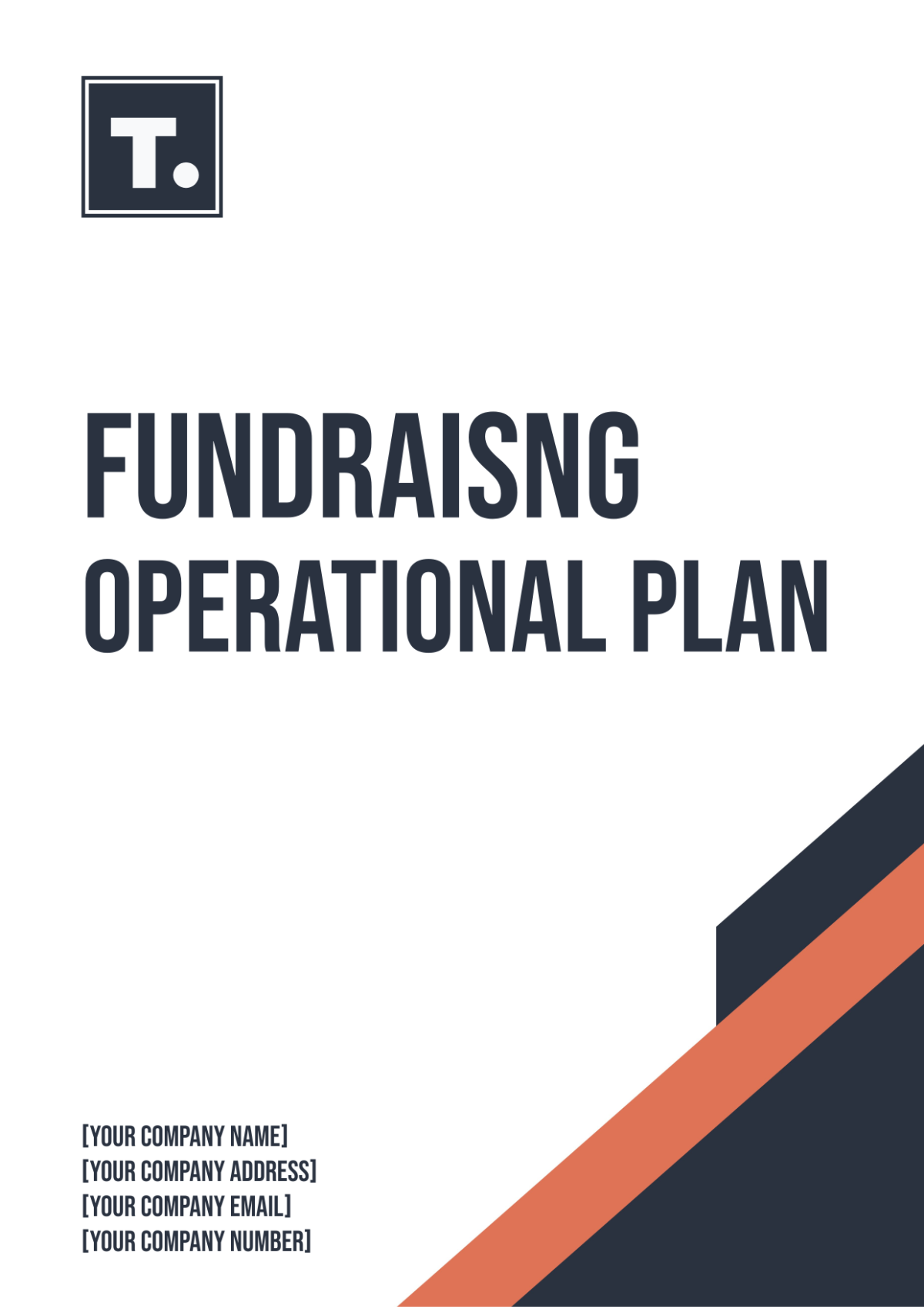
Prepared by | [Your Name] |
Date | [DATE] |
I. Executive Summary
The [Your Company Name] Fundraising Operational Plan outlines the strategies, tactics, and timelines for successfully executing fundraising initiatives to support our mission and goals. This document provides a comprehensive overview of the fundraising activities planned for the upcoming 2050 while addressing potential risks and mitigation strategies. Additionally, it delineates the roles and responsibilities of team members involved in the fundraising process.
II. Goals and Objectives
A. Fundraising Goals
Goal 1: Raise $10,000,000 in funds to support climate change initiatives.
Goal 2: Increase donor retention rate by 15%.
Goal 3: Expand donor base by acquiring 5,000 new donors.
B. Objectives
Develop targeted fundraising campaigns to achieve fundraising goals.
Cultivate relationships with existing donors to increase their engagement and contributions.
Implement strategies to attract new donors and diversify funding sources.
Enhance donor stewardship practices to ensure long-term support and loyalty.
III. Strategy Overview
A. Campaign Planning
Campaign Name: Climate Action Now
Timeline: Jan 1, 2050 - Dec 31, 2050
Target Audience: Environmental activists, corporations, and individuals passionate about sustainability.
Goal: Raise $5,000,000 for renewable energy projects.
B. Donor Cultivation
Segmentation: Categorize donors based on giving history, interests, and capacity.
Communication Plan: Personalized outreach via email, phone calls, and events.
Recognition: Acknowledge donors through personalized thank-you letters, events, and public recognition.
IV. Fundraising Tactics
A. Online Fundraising
Website Donation Page: Optimize for user experience and mobile responsiveness.
Email Campaigns: Regular updates, appeals, and donor stories.
Social Media: Engage followers with compelling content and calls to action.
B. Events and Campaigns
Virtual Events: Webinars, livestreams, and virtual galas.
Peer-to-Peer Fundraising: Empower supporters to raise funds on our behalf.
Matching Gift Programs: Encourage employers to match employee donations.
V. Timeline and Milestones
A. Quarterly Fundraising Calendar
Q1 (Jan - Mar): Launch the Climate Action Now campaign, and host a virtual fundraising event.
Q2 (Apr-Jun): Implement donor stewardship activities, and plan a mid-year giving campaign.
Q3 (Jul - Sep): Execute peer-to-peer fundraising campaign, and explore corporate partnerships.
Q4 (Oct-Dec): Year-end appeal, review fundraising performance, plan for next year.
B. Milestones
[Date]: Secure 30% of the fundraising goal.
[Date]: Reach 2,000 new donors through targeted outreach.
[Date]: Host a successful fundraising event with 500 attendees.
VI. Budget and Resources
A. Budget Allocation
Category | Allocation |
|---|---|
Personnel | $500,000 |
Marketing | $200,000 |
Events | $300,000 |
Technology | $100,000 |
B. Resource Requirements
Resource | Description |
|---|---|
Staff | Dedicated fundraising team members |
Technology | CRM software, online fundraising platforms |
Materials | Marketing collateral, event supplies |
VII. Risk Management
A. Identified Risks
Economic Downturn: Potential decrease in donor contributions due to economic uncertainty.
Donor Fatigue: Donor burnout resulting from frequent solicitations and appeals.
Technological Issues: Disruption of online fundraising activities due to technical glitches or cyber-attacks.
Regulatory Changes: Changes in fundraising regulations impact our ability to solicit donations.
B. Mitigation Strategies
Diversification of Revenue Streams: Explore alternative funding sources beyond individual donations.
Donor Engagement Strategies: Implement personalized communication to maintain donor interest and reduce fatigue.
Cybersecurity Measures: Regularly update security protocols and invest in cybersecurity training for staff.
Compliance Monitoring: Stay informed about changes in fundraising regulations and adapt strategies accordingly.
VIII. Roles and Responsibilities
[Your Name], Fundraising Director: Overall responsibility for fundraising strategy and execution.
John Smith, Fundraising Coordinator: Coordinates fundraising campaigns, manages donor communications, and tracks progress toward goals.
Emily Johnson, Marketing Manager: Develops marketing collateral, manages social media campaigns, and promotes fundraising events.
Michael Brown, Events Coordinator: Plans and executes fundraising events, manages logistics, and coordinates with vendors.
Sarah Davis, Donor Relations Manager: Cultivates relationships with donors, oversees donor stewardship activities, and ensures donor recognition.
IX. Monitoring and Evaluation
A. Key Performance Indicators (KPIs)
Donation Revenue: Track total funds raised and compare against goals.
Donor Retention Rate: Measure the percentage of donors who continue to support.
Engagement Metrics: Monitor website traffic, email open rates, and social media engagement.
B. Reporting and Analysis
Monthly Reports: Summarize fundraising activities, achievements, and challenges.
Quarterly Reviews: Evaluate progress towards goals and adjust strategies as needed.
Annual Review: Reflect on overall fundraising performance and set objectives for the next year.
X. Conclusion
The success of the fundraising efforts outlined in this operational plan will be vital in fulfilling the mission and advancing our impact on environmental conservation. By implementing targeted strategies, leveraging resources effectively, and fostering strong donor relationships, we aim to exceed our fundraising goals and create lasting positive change.
- 100% Customizable, free editor
- Access 1 Million+ Templates, photo’s & graphics
- Download or share as a template
- Click and replace photos, graphics, text, backgrounds
- Resize, crop, AI write & more
- Access advanced editor
Boost your fundraising efficiency with the Fundraising Operational Plan Template from Template.net. This customizable, editable template is designed for seamless planning. Tailor every detail effortlessly with our Ai Editor Tool, ensuring your plan meets all your unique needs. Streamline your fundraising operations today with this user-friendly and professional template.
You may also like
- Finance Plan
- Construction Plan
- Sales Plan
- Development Plan
- Career Plan
- Budget Plan
- HR Plan
- Education Plan
- Transition Plan
- Work Plan
- Training Plan
- Communication Plan
- Operation Plan
- Health And Safety Plan
- Strategy Plan
- Professional Development Plan
- Advertising Plan
- Risk Management Plan
- Restaurant Plan
- School Plan
- Nursing Home Patient Care Plan
- Nursing Care Plan
- Plan Event
- Startup Plan
- Social Media Plan
- Staffing Plan
- Annual Plan
- Content Plan
- Payment Plan
- Implementation Plan
- Hotel Plan
- Workout Plan
- Accounting Plan
- Campaign Plan
- Essay Plan
- 30 60 90 Day Plan
- Research Plan
- Recruitment Plan
- 90 Day Plan
- Quarterly Plan
- Emergency Plan
- 5 Year Plan
- Gym Plan
- Personal Plan
- IT and Software Plan
- Treatment Plan
- Real Estate Plan
- Law Firm Plan
- Healthcare Plan
- Improvement Plan
- Media Plan
- 5 Year Business Plan
- Learning Plan
- Marketing Campaign Plan
- Travel Agency Plan
- Cleaning Services Plan
- Interior Design Plan
- Performance Plan
- PR Plan
- Birth Plan
- Life Plan
- SEO Plan
- Disaster Recovery Plan
- Continuity Plan
- Launch Plan
- Legal Plan
- Behavior Plan
- Performance Improvement Plan
- Salon Plan
- Security Plan
- Security Management Plan
- Employee Development Plan
- Quality Plan
- Service Improvement Plan
- Growth Plan
- Incident Response Plan
- Basketball Plan
- Emergency Action Plan
- Product Launch Plan
- Spa Plan
- Employee Training Plan
- Data Analysis Plan
- Employee Action Plan
- Territory Plan
- Audit Plan
- Classroom Plan
- Activity Plan
- Parenting Plan
- Care Plan
- Project Execution Plan
- Exercise Plan
- Internship Plan
- Software Development Plan
- Continuous Improvement Plan
- Leave Plan
- 90 Day Sales Plan
- Advertising Agency Plan
- Employee Transition Plan
- Smart Action Plan
- Workplace Safety Plan
- Behavior Change Plan
- Contingency Plan
- Continuity of Operations Plan
- Health Plan
- Quality Control Plan
- Self Plan
- Sports Development Plan
- Change Management Plan
- Ecommerce Plan
- Personal Financial Plan
- Process Improvement Plan
- 30-60-90 Day Sales Plan
- Crisis Management Plan
- Engagement Plan
- Execution Plan
- Pandemic Plan
- Quality Assurance Plan
- Service Continuity Plan
- Agile Project Plan
- Fundraising Plan
- Job Transition Plan
- Asset Maintenance Plan
- Maintenance Plan
- Software Test Plan
- Staff Training and Development Plan
- 3 Year Plan
- Brand Activation Plan
- Release Plan
- Resource Plan
- Risk Mitigation Plan
- Teacher Plan
- 30 60 90 Day Plan for New Manager
- Food Safety Plan
- Food Truck Plan
- Hiring Plan
- Quality Management Plan
- Wellness Plan
- Behavior Intervention Plan
- Bonus Plan
- Investment Plan
- Maternity Leave Plan
- Pandemic Response Plan
- Succession Planning
- Coaching Plan
- Configuration Management Plan
- Remote Work Plan
- Self Care Plan
- Teaching Plan
- 100-Day Plan
- HACCP Plan
- Student Plan
- Sustainability Plan
- 30 60 90 Day Plan for Interview
- Access Plan
- Site Specific Safety Plan
